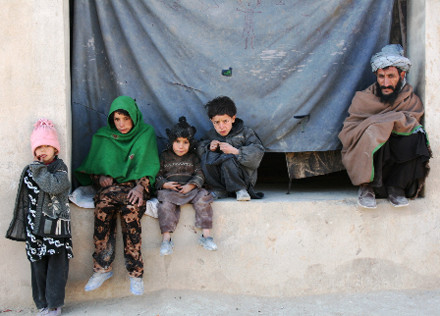Over 100,000 people have been forced out of their homes by clashes in different parts of Afghanistan over the past 12 months but by no means all of them have received aid, according to aid agencies and affected people.

IDPs are particularly vulnerable to to malnourishment, diseases and exploitation by criminal and insurgent groups. (Photo: Akmal Dawi/IRIN)
The International Committee of the Red Cross (ICRC) says civilians are trapped in a difficult environment: “One armed group may demand food and shelter in the evening and an opposing side demand justification for harbouring an enemy in the morning,” ICRC spokesman Bijan Frederic Farnoudi told IRIN.
“Many families see fleeing as their only solution,” he said, adding that internally displaced persons (IDPs) were “living a life of misery and poverty”.
The ICRC, which works in collaboration with the Afghan Red Crescent Society and has better access to conflict-affected areas than UN agencies, said it had assisted about 20,000 of the over 100,000 civilians displaced by fighting since last year.
Armed violence has reached unprecedented levels since the Taliban ouster in 2001, and civilians have increasingly borne the brunt of the violence, aid agencies say.
The number of IDPs in Afghanistan is estimated at about 300,000 by the UN Refugee Agency (UNHCR) and over 450,000 by the Ministry of Refugees and Returnees (MoRR). Most are residuals from the over one million displaced before 2001 due to conflict, poverty and natural disasters.
The official assistance programme to IDPs ended in 2006 as government officials, backed by UNHCR, advised people to return to their original areas, and prevented the setting up of new camps, but tens of thousands of IDPs are still in camps in the southern provinces of Kandahar and Helmand and in the western province of Herat.
Violence spreading
Insecurity has, meanwhile, rapidly spread to the previously peaceful northern and central parts of the country: At least 200 families left their homes in Imaam Sahib District in the northern province of Kunduz over the past three months, the provincial ARCS office said.
“The Taliban have established a presence in Archin, Chardara and Imaam Sahib districts as a result of which some families are leaving the areas,” said Mahbubullah Faizi, spokesman of Kunduz governor Mohammad Omar who was killed in a blast on 8 October.
Hundreds of families allegedly displaced by conflict in the northeastern province of Kapisa have sought shelter in the eastern outskirts of Kabul.
No clear mandate to assist IDPs
Internal displacement in Afghanistan is a “highly politicized and controversial” issue, according to a May 2010 report by the Brookings Institution and The Liaison Office (TLO), a Kabul-based NGO.
"The problem is twofold: first no organization has a clear mandate to assist IDPs, and second, IDPs are often labelled economic migrants,” Susanne Schmeidl, a TLO researcher and author of the report, told IRIN.
The Afghan government has ultimate responsibility for assisting and protecting IDPs. The UN Guiding Principles on Internal Displacement say (Principle 25): “The primary duty and responsibility for providing humanitarian assistance to internally displaced persons lies with national authorities,” but they are not legally binding.
Backed by aid agencies, the government categorizes IDPs into three groups: 1) conflict-induced IDPs, 2) disaster-induced IDPs, and 3) protracted IDPs. It treats conflict-related displacement as a temporary issue.
“Our policy is to make sure IDPs return to their original homes when security improves,” said MoRR spokesman Islamudin Joraat.
NRC concerns
However, Charlotte Esther Olsen, country director of the Norwegian Refugee Council (NRC), highlighted some concerns: “Conflict induced displacement situations are not temporary phenomena that automatically ‘disappear’ when one party to the conflict takes control of an area.”
She also noted the difficult environment: “The precarious situation of IDPs in Afghanistan is a result of insecurity and violence which also increasingly prevents the humanitarian community from accessing locations of displaced populations without putting the safety of their staff at grave risk.”
All IDPs had the right to protection and assistance, she said, but many were not receiving these in adequate measure.
MoRR, which is responsible for refugees and returnees but also deals with IDPs, has weak capacity and lacks resources, say MoRR officials. As in other areas, the government relies heavily on assistance from donors and aid organizations and the latter are severely restricted by access problems.
Abandoned?
Many IDPs in Kandahar, Kabul and Helmand provinces said they had been abandoned by the government and aid agencies.
As the conflict spreads, the number of IDPs is expected to rise in the coming months, experts say, but if they remain unprotected and unassisted IDPs can easily be exploited by the insurgency, said TLO’s Schmeidl.
“There is a dual failure towards IDPs: first they are left unassisted and unprotected; second they are blamed for their alleged involvement with the insurgency,” she said, adding that instability could worsen if the IDP problem remains unaddressed.



